About Varroa mite of honey bees
Varroa mite – current situation
For the latest on the varroa mite read current situation.
About varroa mites
Varroa mite (Varroa destructor and Varroa jacobsoni) is a parasite of adult honey bees and honey bee brood. It weakens and kills honey bee colonies and can also transmit honey bee viruses. Varroa was detected in NSW in June 2022. A national eradication response was conducted following the detection, but has now been determined not to be feasible to achieve eradication. The response is now transitioning to ongoing management of the pest.
Description
Adult female varroa are reddish-brown, shaped like a scallop shell, about 1.1 mm long and 1.7 mm wide and visible to the naked eye.
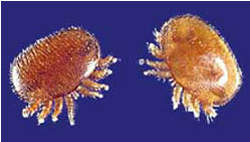
Adult males are smaller and are yellowish-white. Both sexes have eight legs.
The eggs are 0.5 mm long, milky-coloured and at first rounded.
Females of Varroa jacobsoni, a closely-related exotic species, are smaller than females of V. destructor, being about 1.0 mm long and 1.5 mm wide.
Life cycle
Varroa only produce offspring when honey bee brood is present in hives.
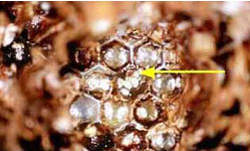
Mated female varroa enter drone and worker brood cells containing mature larvae just before hive bees cap the cells. The female varroa move to the base of the cell and submerge themselves in the larval food. When the cell is capped, the submerged mites move to the larva and begin feeding.
Individual females lay up to 6 eggs, beginning about 60 to 70 hours after the cell was capped and thereafter at intervals of about 30 hours. The first egg laid is male and all the others are female. Eggs are laid on the base and walls of the cell, and sometimes on the developing bee.

Development of female varroa from egg to adult takes about 8 to 10 days. The long interval between the laying of individual eggs means that mites of different stages of development may be seen in the one cell. Protonymphs hatch from eggs about 12 hours after laying. A larger duetonymph stage occurs before the final adult stage.
The single male Varroa mates with its sisters while they are in the brood cell.
When the new adult bee emerges from its cell, the young varroa females and mother mite also leave the cell, often on the emerging bee.
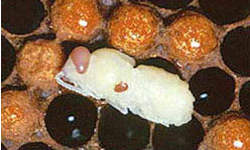
The daughter mites feed on adult bees and after a short period enter other brood cells to lay eggs.
The males live for only a short time inside sealed brood cells and are never seen outside the cell.
How Varroa spreads
The mites are very mobile and readily transfer between adult bees.
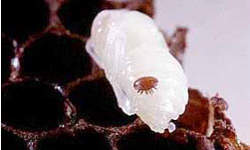
Varroa spread between colonies and apiaries when hive components, infested brood and adult bees are interchanged during normal apiary management practices.
The transport of hives, used beekeeping equipment and queen bees by beekeepers is also a very effective means of spread. In Australia, the spread of varroa is expected to be fast over long distances because of the migratory nature of the beekeeping industry.
Foraging and drifting bees and swarms can also spread varroa. In the case of foragers, mites can move from the bee to a flower and then hitch a ride with another bee or insect visiting the same flower. Varroa is not spread in honey.
Field diagnosis
Field diagnosis of exotic honey bee parasites and pests in beehives provides detailed notes on the field diagnosis of Varroa.
All stages of the mite are difficult to detect. In lightly infested colonies they are mostly found in sealed brood cells. The mites may be seen on drone and worker pupae in sealed brood cells. It is first necessary to uncap these cells and remove the pupae for examination.
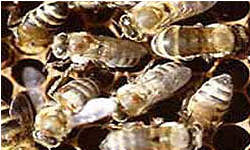
Female mites may be found on adult bees, especially in over-wintering colonies that have no honey bee brood. They may be found between the first abdominal segments of an adult bee where they hide between the sclerites.
Mite numbers increase slowly within a hive. It may not be until the fourth year of infestation that numbers are sufficiently high for honey bee larvae to be parasitised by several females. When this occurs, newly emerged adult bees with deformed wings, legs and abdomens may be found at the hive entrance.
Patchy brood patterns may also be seen in advanced infestations. Colonies affected to this extent will usually die.
How to test for arthropod pests such as Varroa mite and Tropilaelaps
There are three tests commonly used to detect varroa mite and other pests, including alcohol wash, sugar shake and drone uncapping.
Varroa – a notifiable disease
If you see or suspect varroa is present in your apiary, you must report it immediately by calling the Exotic Plant Pest Hotline: 1800 084 881 (24 hours a day, every day of the year).
Notification is required by the Livestock Disease Control Act (1994). To not notify is to break the law.
Early recognition of varroa is one of the most important factors influencing the chance of eradication and reducing economic and social impact on the whole community.
Further information
If you require further information or assistance, please contact the Customer Service Centre on 136 186 or email honeybee.biosecurity@agriculture.vic.gov.au